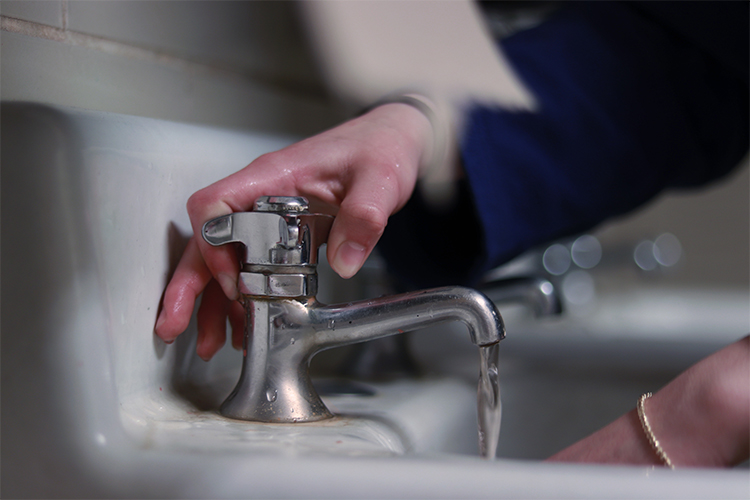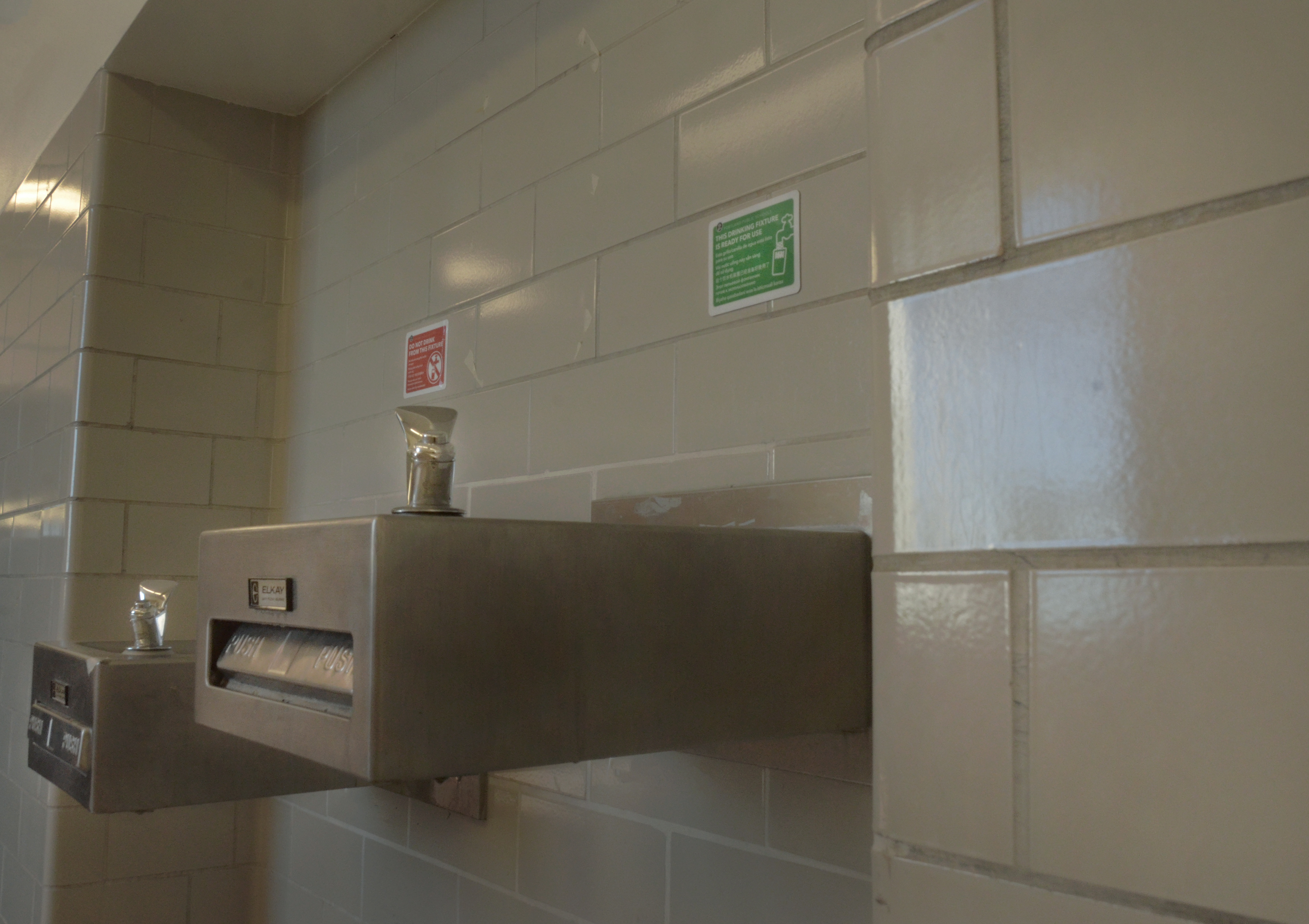
In late 2018, several water coolers placed around Grant High School as a response to the 2016 lead findings were removed as many water fountains around the school reopened. Slowly, the dozens of five-gallon water jugs strewn around the school decreased to just a few. In the end, only two water stations remained, the rest replaced by green placards above the reopened water fountains. The change sparked much conversation in the Grant community and prompted some students to figure out why the fountains had reopened and if their water was safe to drink.
William Morton, a senior at Grant, was one of these students. After hearing complaints from other students of brown water from several drinking fountains, Morton decided to conduct his own tests to find out if the water was indeed safe to drink.
After ordering a free test kit from the Portland Water Bureau, Morton returned to the Marshall campus and filled a small container with water from a fountain on the C-floor. Morton mailed his sample to the Portland Water Bureau, waiting two weeks before receiving a short reading of the results.
Morton’s tests found that the water was not only well below the district’s action level for lead, but almost entirely free of the substance.
Like Morton and the district’s tests suggest, the water in marked fountains around Grant is not dangerously high in lead.
But many students remain unsure about the quality of the water. According to a Grant Magazine survey given in early March of 2019 to over 200 Grant students, 92.4 percent do not trust the Portland Public Schools (PPS) water program, and 71.7 percent choose not to drink from the reopened fountains.

The district’s reasons for removing the water coolers were not made widely known to students, which seems to have amplified concerns among members of the community. When asked about the state of the drinking fountains at the Marshall campus, Grant High School’s principal Dr. Carol Campbell stated that the district had not provided her with much additional information. “I’m not even sure what was done to the water fountains,” Dr. Campbell says.
Junior Ella Shanahan cites the district’s historical lack of transparency about water quality throughout the lead crisis of 2016 as one of the major factors in the distrust between students and the PPS water program. “(The district) said it was fine before, but it actually wasn’t, so if you’re saying it’s fine to drink now, we don’t know if they’re telling the truth,” says Shanahan.
To fully understand the cause of the Grant community’s lack of trust in the PPS water program, Grant Magazine took an in-depth look into the history of the 2016 PPS lead crisis.
The beginnings of what Dr. John Burnham, the senior director of school modernization who coordinates health and safety at PPS, refers to as the “PPS lead crisis” can be traced back to as early as July of 2001. At this time, PPS conducted what would be their last district-wide lead test for 15 years.
Between 2001 and 2016, lead testing in PPS schools was sporadic, mostly unregulated and often only conducted at the request of parents or staff members.
An internal audit of the 2016 PPS water scandal by law firm Stoll Berne found that “because testing and remediation for lead in water by schools is not regulated (by state or federal law), it has gone predominantly unaddressed by PPS.” Stoll Berne also revealed that PPS instead allocated their limited funding to fixing buildings and infrastructure.
According to the investigation, what little water testing that took place before 2016 was recorded in an unreliable database managed by Patrick Wolfe, the senior manager of Environmental Health and Safety at PPS. The Stoll Berne law firm was unable to talk to Wolfe about the database as he passed away in 2016 before the investigation began.
In March of 2016, lead testing began at Creston K-8 School at the request of parents, and three of the 10 fixtures tested contained lead levels above the PPS toxic metals action of 15 parts per billion (ppb).
Results arrived on April 3rd, but repairs only finished eight days later. During that period, fountains and sinks containing elevated lead levels were not shut off or blocked, and no signage was added to warn the students and staff not to drink the water. The Environmental Protection Agency (EPA) protocol states that if results show elevated levels of lead, the school should take “immediate steps to remove outlets from service or prevent use.”
It was not until April 16 that parents learned the results of the lead testing. After being notified, parents requested tests for all of the fixtures in the school. On May 10, the results of these tests showed that all 12 drinking fountains had under 15 ppb, but four of the 38 sinks had elevated lead levels, including one kitchen sink.
By May 18, all of Creston’s fixtures had been fixed aside from the kitchen sink, which did not receive repairs due to an internal miscommunication. Breaking EPA protocol once again, these fixtures remained on, without any signage warning of the results or anything blocking them off for the entire remediation process.
As lead testing began at Creston, Rose City Park Elementary School quickly followed suit. Less than two weeks later, results from lead tests on all of the fixtures at Rose City Park found lead concentrations in two fountains and six sinks to be above 15 ppb.
On May 26, 2016, PPS released a statement to the public that Creston K-8 and Rose City School had numerous water fixtures with water lead levels that exceeded 15 ppb.
Students and parents from Rose City School received blood tests, and two children were found to have elevated levels of lead in their blood. However, these blood tests only revealed if a person has been exposed to lead in the last three months and did not include the total concentration of lead in their body.
Despite the findings from Creston and Rose City Park, PPS hesitated at first to inform families about the contaminated water, sparking distrust throughout the communities. In an email from PPS, the school board admitted that they did not follow the EPA suggested contaminant protocol of immediately shutting off any water fixture with elevated lead levels, and that even after completing lead testing they had allowed students to drink from contaminated fixtures.
Furthering the community’s distrust, PPS shut off all water fixtures in the district on May 27, 2016, without the release of any test results from schools other than Creston or Rose City School.
Information from lead tests completed throughout PPS at the beginning of June and July in 2016 was released, and it became clear that nearly all of the buildings in the district were affected, including the Northeast Portland campus of Grant High School, which recorded several water sources with lead levels exceeding 15 ppb, and one fixture in room 237 recording 57,000 ppb.
At the Marshall campus, the test results revealed 255 fixtures that surpassed 15 ppb, more than any other building in PPS.
Eli Mones, a junior at Grant who attended ACCESS Academy at the time of the scandal, remembers his parents telling him about the lead contamination in the water after reading the emails sent out by PPS. “When they told me about it, they looked pretty calm, but I’m sure when they read the email, it was a different reaction,” he says. “(My parents) were definitely worried … everybody was pretty upset … that all these kids and people could have been possibly poisoned.”
Eventually, due to the possibility of their son having lead poisoning, Mones’ parents had him tested for measurable blood lead. These tests were not uncommon, with many other parents taking their children to receive the same exams. During 2016, a total of 1,931 PPS students, parents and teachers had their blood tests screened, according to Dr. Burnham.
While Mones’s blood tested negative for lead, others were not as lucky. The screenings found that 115 (four percent) of the people tested had measurable blood lead and 25 (just over one percent) had elevated blood lead. According to Dr. Burnham, students with elevated levels were directed by the district to consult their physician.
While the numbers may sound alarming, the percentage of PPS students with measurable blood lead is similar to lead levels throughout the rest of Multnomah County. Additionally, according to Dr. Burnham, of the students with measurable blood lead, none were traced back to the schools. “The drinking water in schools was one more incremental addition to exposure of lead in your life,” Dr. Burnham says. “Most blood lead issues are due to paint … or dust in their homes from lead paint.”
On July 14, 2016, immediately following the publishing of the Stoll Berne report, Carole Smith resigned as superintendent of PPS. Four days later, in a message to the public announcing her resignation, Smith noted that neither she nor members of the PPS Board of Education “intended harm or to neglect his or her job duties” regarding the lack of transparency about the lead levels in the district.
Dr. Burnham, who has a master’s degree in environmental health and a Ph.D. in chemistry, was brought on as part of the safety leadership team immediately following the results of the test and Smith’s resignation. “We started meeting daily (to) work out all the issues responding to media issues, making media releases, planning on testing, and a number of other issues that came up, like blood lead tests and so forth were discussed a lot back then, and also implemented,” he says.
Dr. Burnham’s team tested lead levels around the district and discussed solutions, eventually shutting shut down around 2,200 water fountains across PPS. “(We) realized that we can’t keep just testing these things, we need to shut them down,” Dr. Burnham says.
After shutting down the fountains in May of 2016, PPS began administering water bottles and installing water coolers in all affected schools. Grant received water bottles at the end of the 2015-16 school year but switched entirely to water coolers by 2017.
According to Dr. Burnham, the primary cause for the district’s efforts to reopen lead-free fountains is due to the expense of supplying water bottles and coolers throughout PPS schools.
The total cost of bottles and water coolers, which initially averaged around $85,000 a month across PPS, has been reduced to $20,000 since the start of the 2018-19 school year.
Though many fixtures throughout the Marshall campus have reopened, it is not hard to spot a red placard above a drinking fountain stating that the fountain is not ready for drinking use. In fact, as of November 2018, six drinking fountains throughout Marshall still tested at above 15 ppb lead.
But a confusing email sent out by PPS last August contradicts this reality. The email states that “the remaining common area fixtures in a small group of schools that were not replaced will have that work completed by November 1, 2018.”
Even years after the panic of 2016, contradictions like this one show that the distrust and confusion surrounding the safety of the water are still present. PPS’s history of faulty communication lingers, leading many to avoid the reopened water fountains even when the numbers say that the water is safe to drink.
The lead crisis left students and parents confused about the organization of PPS safety protocol, and many still have concerns. However, others maintain faith in PPS’s intentions. “I think a lot of the time PPS is trying their hardest, but I still think they get criticized,” Mones says. “I think when it comes to the health and clarity of water, they are doing the most to fix it.”
Despite his trust in the steps PPS has taken to improve the lead issue, Mones says that he still avoids drinking water from the fountains. “(PPS) could get everything lead-free, get rid of all of the jugs and then I’d be confident they know all the water is safe, but right now I don’t really feel that way,” he says.




